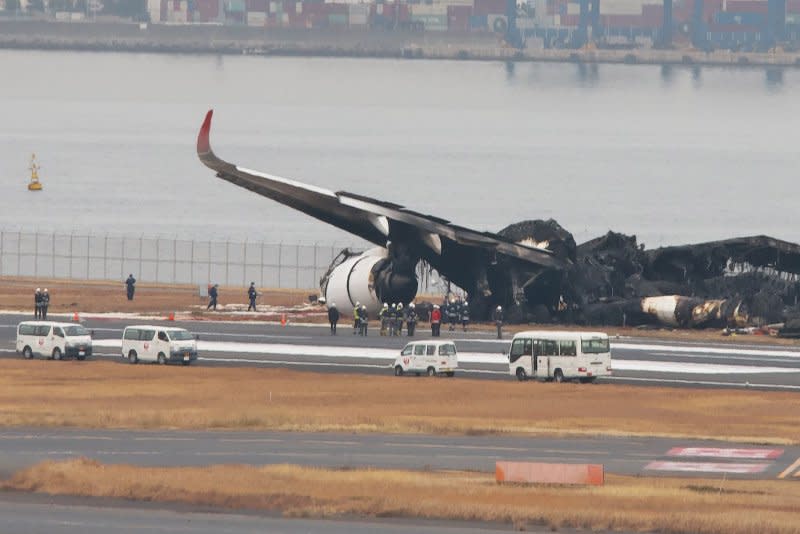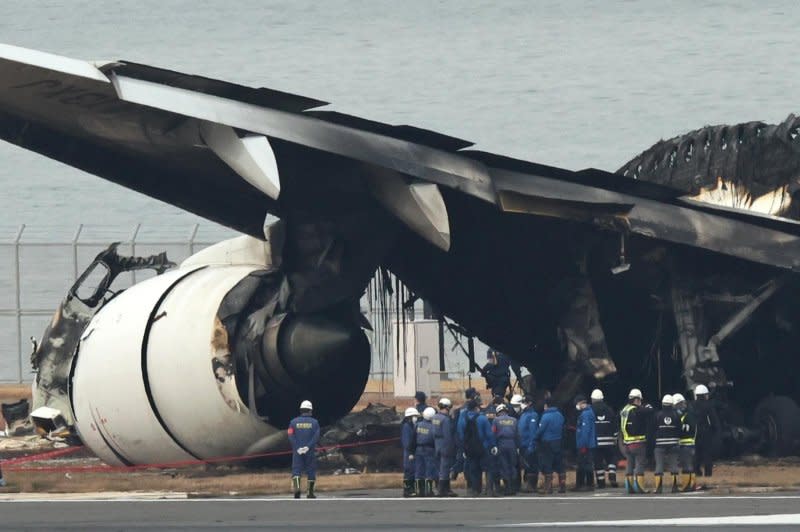Passengers' safe escape from fiery Japan Airlines crash described as 'miracle'

Jan. 3 (UPI) -- Passengers on a Japan Airlines jet, which collided with a Japanese Coast Guard aircraft Tuesday on a Tokyo runway before bursting into flames, are describing their safe escape as a "miracle."
Five of the six people on board the Coast Guard propeller plane died as they were about to take off from Haneda Airport to help victims from Monday's earthquake. But all 367 passengers -- including eight infants -- and 12 crew members on board the Airbus A350 survived.
Only 14 people on the plane were treated for injuries.
On Wednesday, flight experts credited safety features on the plane, which was built to withstand fire, as well as a well-trained crew and well-behaved passengers, for the quick 20-minute evacuation despite facing numerous obstacles.
Japan Airlines' managing executive officer said the announcement system malfunctioned after the crash, forcing the crew to shout and use a megaphone to instruct passengers to safety.

Only three doors and evacuation slides could be used as the other exits from the plane were consumed by fire, according to Japan Airlines spokeswoman Maggie Kuwasaki.
One crew member credited the fact that it was a domestic flight, telling the Washington Post that most of the passengers shared the same language and were likely already well-trained for evacuations in preparation for common natural disasters in their country.
"It is absolutely not common for passengers to comply with instructions, though some countries do better than some of the others, mostly based on ... their sense of crisis awareness," the flight attendant said.
Experts also said a "really significant" component of the quick evacuation was that passengers left their luggage behind.
"I didn't see a single person with their luggage, not a single person," Ed Galea, a professor and leader of the Fire Safety Engineering Group at London's University of Greenwich said in an interview, after examining footage of the evacuation. "I think the crew did a miraculous job."
"It really is a miracle that they got everyone out," said Trisha Ferguson, the chief executive of the Interaction Group that designs airplane safety cards. "The crew was spectacular in their reaction times."
While most of the passengers on board the Japan Airlines jet were Japanese, Anton Deibe, a 17-year-old Swede, said he and his family could not understand the announcements and described the scene as "chaotic."
"The entire cabin was filled with smoke within a few minutes," Deibe's father, Jonas, told the Swedish newspaper Aftonbladet. "We threw ourselves down on the floor. Then, the emergency doors were opened, and we threw ourselves at them."
On Wednesday, the Japan Transport Ministry revealed that the Coast Guard plane did not have permission to enter the runway on which it collided with the Japan Airlines passenger jet, according to flight control communications.
Japan Airlines has said that the plane's crew had "acknowledged and repeated the landing permission from air traffic control, and then proceeded with the approach and landing procedures" before touching down.
Japan's Prime Minister Fumio Kishida reminded reporters that "The root cause of this accident is not known yet," as he offered his condolences to the families of the crew members killed on the Japan Coast Guard plane.
"They were filled with a determined sense of mission, and it is extremely regrettable and distressing what has happened to them," Kishida added. The Coast Guard crew was heading to Japan's Ishikawa prefecture, which had been hit by a powerful 7.5-magnitude earthquake on New Year's Day, killing 62 people.
The French Airbus A350, which was delivered to Japan Airlines in November 2021, is a total loss. The plane's manufacturer announced it was sending a "team of specialists" to Japan to assist in the crash investigation.

